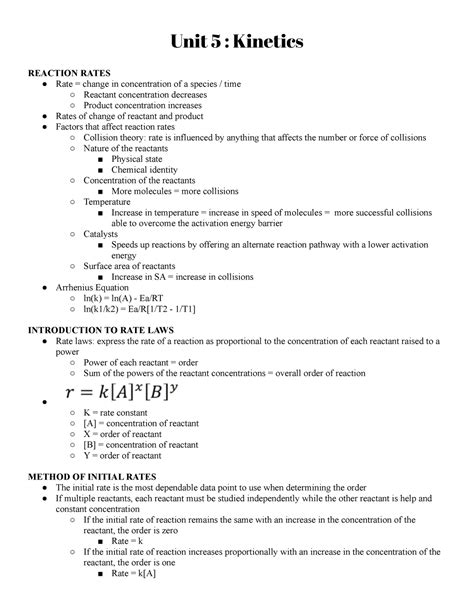Key Concepts:

- Equilibrium: The state of balance in which the forward and reverse reactions of a chemical reaction occur at the same rate.
- Le Chatelier’s Principle: A set of rules that predict how a change in reaction conditions will affect the equilibrium position.
- Equilibrium Constant: A constant that represents the relative concentrations of reactants and products at equilibrium.
Equilibrium Calculations:
1. Determining the Equilibrium Concentrations:
- Use the equilibrium constant expression to set up an ICE table.
- Solve the ICE table for the unknown equilibrium concentrations.
2. Predicting the Reaction Direction:
- Calculate the reaction quotient (Q).
- If Q < K, the reaction will proceed in the forward direction.
- If Q > K, the reaction will proceed in the reverse direction.
3. Calculating the Percent Composition:
- Use the equilibrium concentrations to calculate the mole fractions of reactants and products.
- Multiply the mole fraction by 100% to obtain the percent composition.
Le Chatelier’s Principle:
How to Apply:
- Identify the change in conditions (e.g., temperature, concentration, pressure)
- Apply the appropriate rule from Le Chatelier’s Principle
- Predict the shift in the equilibrium position
Rules:
- Change in Concentration: Increasing the concentration of a reactant shifts the equilibrium towards the product side; decreasing the concentration shifts it towards the reactant side.
- Change in Temperature: Increasing the temperature shifts the equilibrium towards the endothermic side (the side that absorbs heat); decreasing the temperature shifts it towards the exothermic side (releases heat).
- Change in Pressure (for gases only): Increasing the pressure shifts the equilibrium towards the side with fewer gas molecules; decreasing the pressure shifts it towards the side with more gas molecules.
Applications of Equilibrium:
- Optimizing chemical processes (e.g., maximizing product yield)
- Environmental chemistry (e.g., understanding the behavior of pollutants)
- Pharmaceutical industry (e.g., designing drugs that dissociate into active forms at specific pH levels)
- Agricultural chemistry (e.g., controlling soil pH for optimal nutrient availability)
FAQs:
-
What is the importance of equilibrium in chemical systems?
Equilibrium is crucial for controlling the concentrations of reactants and products in many chemical processes. It also helps predict how reactions will behave under different conditions. -
How can I use Le Chatelier’s Principle to predict the direction of a reaction?
By identifying the change in reaction conditions and applying the appropriate rule from Le Chatelier’s Principle, you can predict how the equilibrium position will shift. -
What is the difference between an endothermic and an exothermic reaction?
An endothermic reaction absorbs heat, while an exothermic reaction releases heat. These properties affect how the equilibrium position shifts with temperature changes. -
How can I apply equilibrium principles to real-world problems?
Equilibrium concepts find applications in various fields, such as optimizing chemical processes, understanding environmental phenomena, and developing medical treatments. -
What are some innovative applications of equilibrium in modern chemistry?
Researchers are exploring the use of equilibrium in areas like nanomaterial synthesis, targeted drug delivery, and renewable energy storage.
Tables:
Table 1: Equilibrium Constant Expressions
| Reaction | Equilibrium Constant Expression |
|---|---|
| A + B ↔ C | K = [C]/[A][B] |
| 2A ↔ B | K = [B]/[A]^2 |
| A + 2B ↔ 3C | K = [C]^3/[A][B]^2 |
Table 2: Le Chatelier’s Principle Rules
| Change in Condition | Direction of Shift |
|---|---|
| Increase in Reactant Concentration | Shift to Products |
| Decrease in Product Concentration | Shift to Products |
| Increase in Temperature (Endothermic) | Shift to Products |
| Decrease in Temperature (Exothermic) | Shift to Reactants |
| Increase in Pressure (Gases) | Shift to Side with Fewer Gas Molecules |
| Decrease in Pressure (Gases) | Shift to Side with More Gas Molecules |
Table 3: Percent Composition Calculation
| Step | Formula |
|---|---|
| Calculate Mole Fraction (X) of Each Species | X = [Species]/[Total Moles] |
| Convert Mole Fraction to Percent Composition | Percent Composition = X * 100% |
Table 4: Applications of Equilibrium
| Field | Application |
|---|---|
| Chemical Processes | Optimizing Reaction Yields |
| Environmental Chemistry | Understanding Pollutant Behavior |
| Pharmaceuticals | Drug Dissociation Design |
| Agricultural Chemistry | Soil pH Control for Nutrient Availability |
